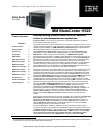
Workhorse 2-socket single- or dual-core Intel Xeon blade server
Please see the Legal Information section for important notices and information.
7.
It is extremely important to include all infrastructure costs when comparing a BladeCenter
solution to a competitor’s offering, not just the cost of the chassis and the blades. The high
density and level of integration of the BladeCenter chassis greatly reduces the cost of the overall
solution. For example, because up to six chassis will fit in a rack, this means that up to 84
blade servers can be installed. (Competitive blade offerings would require a second rack for
this many blades.) Also, because up to four Ethernet, Myrinet, Fibre Channel, InfiniBand or
other switches can be installed per chassis, up to 24 switches can be installed per rack
without having to reserve any “U” space for switches, unlike the competition. (And the integrated
switches may be less expensive than external, self-powered switches.) Plus, the number of
power distribution units (PDUs) needed per rack may be lessened, because there are fewer
discrete devices to have to plug in. In addition, because all the blades are connected to all the
switches inside the chassis, there is no need for external Ethernet or other communication
cables to connect the blades and switches. (Only the few cables needed to connect the
switches to the external world are required.) This not only saves the cost of numerous cables
per rack, but also the clutter and bother of routing that many cables. An added bonus is
potentially much freer airflow behind the rack, due to fewer cables.
BladeCenter H is an even higher-performing 9U chassis, designed for compute-intensive
environments, such as Earth/Life Sciences, commercial analytics and next-generation network
applications. Think of it as BladeCenter’s big brother, with more speed and more features. It
provides:
• Reduced single points of failure — Many major components (either standard or optionally)
are hot-swappable and/or redundant. Servers and modules can be configured for
automatic failover to backups.
• Forward and backward compatibility — Every blade, switch and passthru module released
by IBM for the original BladeCenter chassis since 2002 is supported in the BladeCenter H
chassis.
• High-speed redundant Midplane connections — Based on 4X InfiniBand, the midplane
supports up to 40Gb bandwidth and provides four 10Gb data channels to each blade. By
giving each blade two physical connections to the midplane that connects all blades and
modules together internally, a failure of one connector alone cannot bring down the server.
• Fourteen 30mm blade slots — These hot-swap slots are capable of supporting any
combination of 14 HS20 (Xeon), LS20 (Opteron), and JS20/JS21 (PowerPC 970FX/MP)
blade servers, or 7 double-wide (60mm) HS40 blade servers, or a mixture of 30mm and
60mm blades. It also supports 30mm optional SCSI Storage Expansion Units and/or PCI
I/O Expansion Unit IIs in combination with the blade servers, using the same blade slots. Up
to four chassis can be installed in an industry-standard 42U rack, for a total of up to 56
30mm blade servers per rack.
• Up to ten module slots for communication and I/O switches or bridges — The modules
interface with all of the blade servers in the chassis and alleviate the need for external
switches or expensive, cumbersome cabling. All connections are done internally via the
midplane. Two module slots are reserved for hot-swap/redundant Gigabit Ethernet switch
modules. Two slots support either high-speed bridge modules or legacy Gigabit Ethernet,
Myrinet, Fibre Channel, InfiniBand and other switch modules. Two slots are dedicated for
bridge modules. Four additional slots are dedicated for high-speed bridge modules. All
modules, when in stalled in pairs, offer load balancing and failover support.
• Integrated switch and bridge modules mean that no additional rack “U” space is
required.
• Two module bays for Advanced Management Modules — The new management module
provides advanced systems management and KVM capabilities for not only the chassis
itself, but for all of the blades and other modules installed in the chassis. The Advanced
Management Module provides capabilities similar to the IBM Remote Supervisor Adapter II
used in stand-alone xSeries rack and tower servers. New features include concurrent KVM
(cKVM) and media tray, an external Serial over LAN connector, more memory, a more
powerful onboard processor, industry-standard management interfaces
(SMASH/CLP/CIM/HPI), USB virtualization, network failover and backward compatibility with
the original Management Module, among others. The features of the module can be
accessed either locally or remotely across a network. One module comes standard. A
second module can be added for hot-swap/redundancy and failover. The module uses a
USB connection, rather than the PS2 connection of the original Management Module.
• Two module bays for Blower Modules — Two hot-swap/redundant blower modules come
standard with the chassis. They are capable of providing efficient cooling for up to 14 blades.
These modules replace the need for each blade and switch to contain its own fans. The
blowers are more energy efficient than dozens or hundreds of smaller fans would be, and
they offer many fewer points of potential failure. BladeCenter H also includes up to twelve
additional hot-swap/redundant fans to cool the power supplies and high-speed switch


















